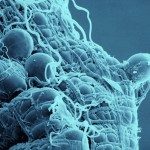Link to Pubmed [PMID] – 12925205
J. Invest. Dermatol. 2003 Sep;121(3):486-9
Darier’s disease is an autosomal dominantly inherited skin disorder, characterized by loss of adhesion between epidermal cells and abnormal keratinization. ATP2A2 encoding the sarcoplasmic/endoplasmic reticulum Ca2+ ATPase (SERCA)2 has been identified as the defective gene in Darier’s disease. All mutations previously reported occur in the region of ATP2A2 encoding both SERCA2a and SERCA2b isoforms. These isoforms result from alternative splicing of exon 20, with SERCA2b being the major isoform expressed in the epidermis. In this report, we studied a family affected with Darier’s disease and identified a deletion (2993delTG) in a region of exon 20 of ATP2A2, which is specific for SERCA2b. This heterozygous mutation predicts a frameshift with a premature termination codon (PTC+32aa) in the eleventh transmembrane domain of SERCA2b. It segregates with the disease phenotype in the family members tested, and functional analysis shows a drastic reduction of the expression of the mutated protein in comparison with the wild-type SERCA2b. Our result suggests that the mutated allele causes the disease phenotype through loss of function of SERCA2b isoform. This finding indicates that SERCA2b plays a key role in the biology of the epidermis, and its defects are sufficient to cause Darier’s disease.

